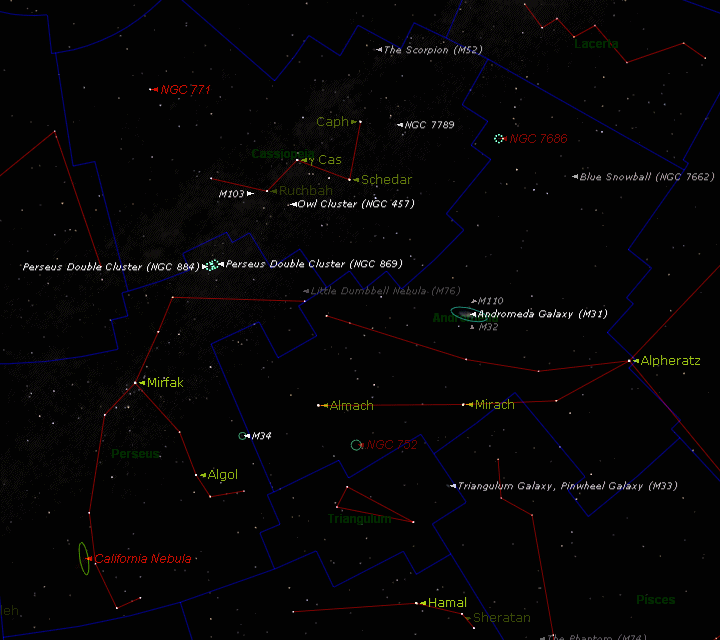
Andromeda
Andromeda is a bright constellation, visible all year round in the northern hemisphere (circumpolar.) and represents the figure of a woman with arms outstretched. It contains the famous spiral galaxy M31, known as the Andromeda Galaxy. On the limit of visibility, at magnitude 4.4, it is the most distant object that can be seen with the unaided eye, and is the nearest galaxy to our own. It can be seen as a misty patch, given good seeing and a very dark background sky, free of light pollution. The Andromeda Galaxy has two companions: M110 ( NGC 205) and M32. M110 is located one degree north west of M31 and M32 can be found half a degree south of M31. Both are elliptical galaxies.
Almach, gamma Andromedae, is a beautiful double star. Even small telescopes can easily divide it’s two components of mags. 2.2 and 4.8. Their beautiful contrasting colours of yellow and blue make this one of the showpiece doubles of the sky.
NGC752 is a large, scatterd wide field cluster of about 60 stars of 9th and 10th mags. NGC7662 is one of the easiest planetary nebulae to see with small telescopes. Under high magnification it appears as a fuzzy blue-green disk with an elliptical outline.
Cassiopeia
This is a well known constellation which represents a woman sitting in a chair. It is a bright constellation lying in a rich part of the Milky Way, close to the celestial north pole and easily recognised by its large W. It can be found on the opposite side of the Pole Star to the Great Bear (Ursa Major – The Plough or Big Dipper.) It contains two open clusters, M52 & M103 , of magnitudes 7.3 & 7.4 respectively.
Cassiopeia is circumpolar, and is visible all year round in the Northern Hemisphere.
Eta Cassiopeiae (star above the last letter “h” of Ruchbah) is a beautiful double star consisting of yellow and red components of 4th and 7th mags.
NGC457, the Owl Cluster, is an attractive cluster for wide field telescopes, including 5th mag. white supergiant Phi Cassiopeiae. The stars of NGC457 are seemingly arranged in chains.
Perseus
Perseus looks likes an inverted Y and contains two of the most beautiful open clusters which sit side by side. NGC869 and NGC884 make up the famous Double Cluster, a related pair of star clusters that form one of the richest sights in the sky for small telescopes. Each cluster covers more than 1/2 degree of sky, with NGC869 being the brighter and richer of the pair. NGC884, however has a beautiful sprinkling of red stars. Both clusters lie about 7400 light years away in a spiral arm of the Milky Way.
Eta Persei (2nd star up from Mirfak) is an attractive double star consisting of orange and blue stars of 4th and 9th mags. in a star sprinkled field.
Algol (beta Persei) is the prototype of the eclipsing binary variables. These consists of two stars in close orbit that periodically pass in front of each other as observed from Earth, causing a variability between mag. 2.1 and 3.4 every 2days and 21 hours.
M34 is a large 5th mag. cluster, easily resolvable in small telescopes.
